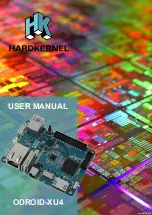
2
ODROID-XU4 USER MANUAL
Differences between a typical PC and a
Single Board Computer (SBC)
If you are used to using a standard PC such as an OSX or
Windows machine, there are a few small differences to note when
transitioning to an ARM device. To begin with, the speed of an ARM
processor is not directly comparable to the speed of an Intel proces-
sor. Because of the efficiency of the CPU, the XU4 can give great
response time that feels just as fast as using a more expensive com-
puter. The operating systems available for the XU4 are also highly
optimized, and benefit from the expertise of many open-source con-
tributors that continually review each others’ work that bring daily
improvements to the OS.
In addition, nearly all of the applications available for the XU4
also have their source code publicly available, which means that
you can freely modify and update the applications to fit your specific
needs. Program authors often maintain a GitHub repository, where
suggestions can be submitted, reviewed and distributed to all of the
application’s users.
The XU4 also uses Solid State technology for its storage me-
dia, although a conventional hard disk may be used as an auxiliary
device. The boot partition can be stored on either a microSD card or
the much faster eMMC module, and Hardkernel’s products have the
unique distinction of supporting removable eMMC modules, so that
operating systems may be switched out conveniently and easily. An
eMMC module is a type of storage typically used in a smart phone,
and is one of the more advanced compact media devices available.
The power consumption of a typical personal computer can
be anywhere between 100W and 1000W or more, depending on the
peripherals, processor and type of power supply used. However, the
ODROID-XU4 uses between 10W and 20W, greatly reducing your
electricity bills, as well as allowing unique power configurations such
as compact solar power cells and long-running batteries.
Components Included on an SBC
The ODROID-XU4 contains many of the same connections as
a typical computer, with 1 USB 2.0 port, 2 USB 3.0 ports, an Ether-
net port that supports Gigabit transfer speeds, an HDMI connector for
720p and 1080p monitors, and a 5V/4A DC power connector. In ad-
dition to these standard inputs, the XU4 also includes a 40-pin GPIO
port, an external RTC battery connector, a USB-UART serial console
port, an eMMC module connector, and a dedicated slot for a microSD
card. For more details, refer to the ODROID-XU4 introductory videos
.
Chapter 1
Содержание ODROID-XU4
Страница 1: ...rev 20170310 ODROID XU4 USER MANUAL ...








































